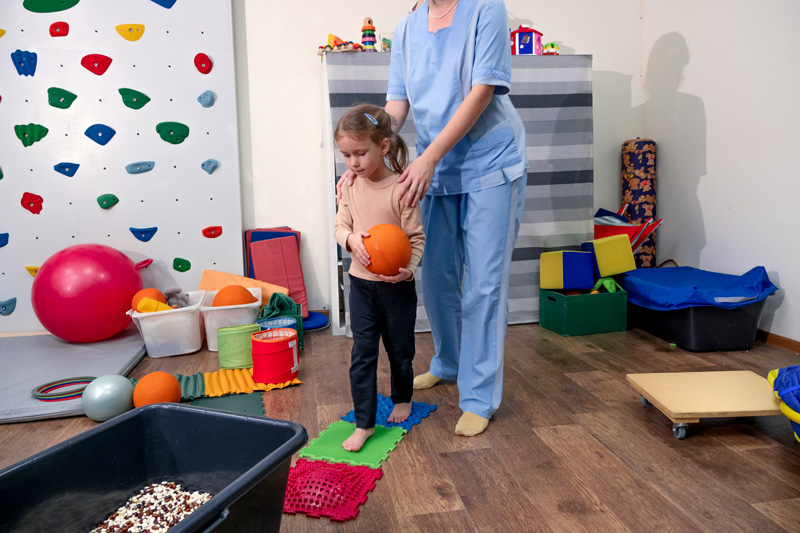Autism Spectrum Disorder (ASD) is a prevalent developmental and neurological disability that affects one in 36 children (CDC, 2023a). Individuals with ASD may have significant impairments in social communication and interaction, restricted or repetitive behaviors or interests, sensory features, and behavioral challenges. The areas affected and the severity of symptoms differs for each individual with ASD (CDC, 2022b; APA, 2013). This variety of needs creates an even greater necessity for effective treatment. Interventions must be supported by empirical evidence and should be individualized to the person in order to best address deficits and promote independence.

Behavior Analysis
Behavioral approaches have the most evidence for treating symptoms of ASD (CDC, 2022c). Behavior Analysts utilize the science of applied behavior analysis by examining what happens before and after a behavior, and, by utilizing this data, develop interventions aimed at improving meaningful behavior. There are several approaches and assessments behavior analysts may utilize including function-based assessment (FBA).
Interventions that are developed from an FBA are an evidence-based approach for individuals with autism who exhibit challenging or interfering behaviors (Steinbrenner et al., 2020). FBAs are a systematic process of gathering information that serves as a means to determine the function/cause of a behavior that may impede learning and engaging in safe and meaningful activities. Once a purpose is determined, an effective intervention plan can be developed (O’Neal et al., 2015; Steinbrenner et al., 2020).
There are four primary functions of behavior including:
- Attention (i.e., gaining access to social attention, good or bad),
- Tangible (i.e., gaining access to desired items, food, etc.),
- Escape (i.e., avoiding demanding tasks, difficult situations, unpleasant stimuli, etc.), and
- Automatic/Sensory (i.e., sensory input, internally maintained).
It is important to consider that the functions of behavior are not always straightforward. Some behaviors may have multiple functions. Behaviors are also dynamic, and the function may change over time (O’Neal et al., 2015).
When a function is determined to be automatic, the behavior is maintained by non-social, environmental consequences and are reinforced by internal sensory consequences. Some examples of automatic behaviors include hand flapping or echolalia. These behaviors don’t tend to hinder learning or cause a problem for the individual. Other behaviors such as self-injury, aggression, or destructive behaviors, can interfere with learning or cause serious harm to themselves and others, and therefore an effective intervention for these behaviors is imperative.
Occupational Therapy
Occupational Therapy (OT) practitioners including occupational therapists and occupational therapy assistants are allied health professionals trained to work with a variety of populations to improve overall participation in meaningful occupations (e.g., activities of daily living such as dressing and self-feeding, and instrumental activities of daily living such as housework and chores, play, etc.) (AOTA, 2020). When an individual with ASD is experiencing challenges in participation, one therapeutic approach is sensory integration (SI) theory.
SI theory is one of several theories used by OT practitioners to guide assessment and intervention. SI is the neurological process individuals use when receiving and organizing information through their body’s sensory systems, and the responses the individual has to the environment (Bundy & Bulkeley, 2020). The goal of SI theory is to improve functional outcomes by identifying, remediating, and preventing deficits within the area of sensory dysfunction, sensory-perceptual skills, and praxis (Roley et al., 2009). For example, individuals with ASD may be hyper-responsive to loud noises, seek movement by displaying repetitive movements (i.e., rocking), or be hypo-responsive to different input (Watling & Hauer, 2015; Lang et al., 2022). When these sensory features have a negative impact on participation, an effective intervention is essential (Watling & Hauer, 2015).
SI theory was created by Jean Ayres in the 1950s (Schoen, Miller, & Nielsen, 2014). When applying SI theory, OT practitioners may utilize Ayers Sensory Integration® (ASI®) or Sensory Based Interventions (SBI) to support individuals with ASD (Watling & Hauer, 2015). ASI® is a manualized intervention provided by OT practitioners who have advanced training and is considered an evidence-based intervention for individuals with ASD (Schaaf & Mailloux, 2015; Steinbrenner, et al., 2020; Watling & Hauer, 2015).
SBI differs from ASI® in that SBIs are adult directed interventions by providing different sensory modalities, such as a weighted vest or compression body socks. It is important to note that SBI should be implemented in a data-driven way and modified based on the response of clients. With this being said, there is a need for ongoing evidence to consider it an evidence-based approach for individuals with ASD. Although these two vastly different approaches are used to treat sensory features for individuals with autism, they both have the same goals; to promote attention and self-regulation to support the needs of clients (Watling & Hauer, 2015).
Benefits of OT and BA Collaboration
OT practitioners and behavior analysts are two professionals trained to treat clients with ASD and have similar goals to improve the outcomes of clients. Collaboration between professions is imperative to increase the likelihood of client success (Whiting & Muirhead, 2019). These professions can collaborate in many different areas, but one area in particular is regarding automatically maintained functions of behavior, that is determined within an FBA completed by the behavior therapist. This function of behavior could be the result of sensory dysfunctions, including but not limited to sensory seeking, hyper-responsive, or hypo-responsive. OT practitioners are skilled in the area of sensory dysfunctions, and through thorough assessment, are able to provide clinical accommodations and/or recommendations to clients with sensory maintained behavior.
OT practitioners can contribute to the intervention package by recommending alternative sensory activities which match the same sensory function as the interfering behavior. For example, if a child is engaging in dangerous climbing behaviors and does not demonstrate awareness of safety, they may need more proprioceptive input. This may be providing frequent breaks to jump on a trampoline, be provided with body squeezes, rolling on a large therapy ball, participating in heavy work or play activities, etc.
Additionally, when an OT practitioner identifies sensory activities that benefit an individual, collaborating with a behavior analyst on a delivery schedule would be beneficial. For instance, these stimulating or regulating items or activities could be used as an antecedent intervention plan such as environmental enrichment or as a non-contingent reinforcement (NCR) procedure. NCR is presented completely independent of the targeted behavior and is provided on a fixed-time or variable-time schedule (Cooper et al., 2019). In the above example, the individual could be provided with frequent, scheduled breaks incorporating activities to provide proprioceptive input. This would be provided regardless of the unsafe climbing behavior. The behavior analyst would monitor to ensure the schedule of reinforcement is appropriate and serving as a replacement. This would especially be necessary in order to avoid unintentionally reinforcing the problem behavior. The OT practitioners would monitor to ensure the sensory-based activities are providing the necessary input in a safe manner and have a regulating effect. Together, both professionals can collaborate to provide a comprehensive and individualized intervention package.
Kristina Gasiewski, MOTR/L, M.Ed., BCBA, is Adult Clinical Services ICF at Melmark PA. Caleigh Dion, OT, MSOT, OTR, is an Occupational Therapist at Melmark New England.
Kristina recently has transitioned into her new role as the behavior analysist/QIDP in adult clinical services. Previously she worked as a school-based occupational therapist. Being dually credentialed, her research interests include collaboration between occupational therapists and behavior analysts and bridging the gap in order to best serve individuals with autism and developmental disabilities.
References
American Occupational Therapy Association. (2020). Occupational therapy practice framework: Domain and process (4th ed). American Journal of Occupational Therapy, 74(Suppl. 2), 7412410010. https://doi.org/10.5014/ajot.2020.74S2001.
American Psychiatric Association. (2013). Diagnostic and statistical manual of mental disorders (5th ed.). Washington, DC: Author.
Bundy, A., & Bulkeley, K. (2020). Using sensory integration theory in coaching. In A. Bund & S. Lane (Eds.), Sensory integration: Theory and practice (3rd edition; pp. 393-415). FA Davis.
Case-smith, J., O’Brien, J. C. (2015). Occupational Therapy for Children and Adolescents. St. Louis, Missouri: Elsevier.
Centers for Disease Control and Prevention. (2023a, April 4). Data and Statistics on Autism Spectrum Disorder. https://www.cdc.gov/ncbddd/autism/data.html.
Centers for Disease Control and Prevention. (2022b, March 28). Signs and Symptoms of Autism Spectrum Disorder. https://www.cdc.gov/ncbddd/autism/signs.html
Centers for Disease Control and Prevention. (2022b, March 9). Treatment and Intervention Services for Autism Spectrum Disorder. https://www.cdc.gov/ncbddd/autism/treatment.html
Cooper, J. O., Heron, T. E., & Heward, W. L. (2019). Applied Behavior Analysis (3rd Edition). Hoboken, NJ: Pearson Education.
O’Neill, R. E., Albin, R., Storey, K., Horner, R. H., W., & Sprague, J. R. (2015). Functional analysis of problem behavior: A practical handbook (3rd ed.). Cengage Learning.
Roley, S. S., Bissell, J., Clark, G. F., & Commission on Practice (2009). Providing occupational therapy using sensory integration theory and methods in school-based practice. The American journal of occupational therapy: official publication of the American Occupational Therapy Association, 63(6), 823–842. https://doi.org/10.5014/ajot.63.6.823
Schaaf, R. C., & Mailloux, Z, (2015). Clinician’s guide for implementing Ayres Sensory Integration® Promoting participation for children with autism. Bethesda, MD: American Occupational Therapy Association, Inc.
Schoen, S., Miller, L., & Nielsen, D. (2014). Sensory integrative theory and treatment occupational therapy with a sensory integrative approach. In Murray-Slutsky, C. & Paris, B. (Eds.), Autism Interventions Exploring the Spectrum of Autism. Austin, Texas: Hammill Institute on Disabilities.
Steinbrenner, J. R., Hume, K., Odom, S. L., Morin, K. L., Nowell, S. W., Tomaszewski, B., Szendrey, S., McIntyre, N. S., Yücesoy-Özkan, S., & Savage, M. N. (2020). Evidence-based practices for children, youth, and young adults with Autism. The University of North Carolina at Chapel Hill, Frank Porter Graham Child Development Institute, National Clearinghouse on Autism Evidence and Practice Review Team.
Watling, R., & Hauer, S., (2015). Effectiveness of Aryes Sensory Integration® and sensory-based interventions for people with autism spectrum disorder. A systematic review. American Journal of Occupational Therapy
Whiting, C. C., & Muirhead, K., (2019). Interprofessional Collaborative Practice between Occupational Therapists and Behavior Analysis for Children with Autism. Journal of Occupational Therapy, Schools, and Early Intervention









Thank you for addressing this issue. I would love more information about how to recognize and treat sensory integration problems that my adult autistic son has.